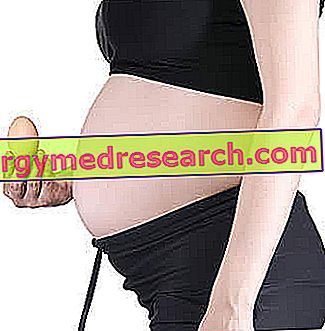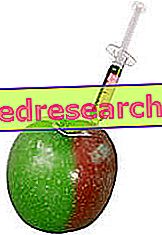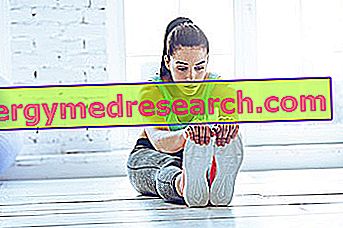Pregnancy Diet
Pregnancy is a special physiological condition that requires a specific adaptation of the diet.
In the past it was widely believed that a pregnant woman should "eat for two", therefore for herself and for the unborn child.

It is necessary to underline that both the excess and the food defect, as well as the presence of harmful molecules (alcohol, nerves, too many additives, pollutants and residues etc.), are potentially harmful for the expectant mother and for the future newborn.
The same applies to the so-called food-borne infectious diseases which, depending on the specific case, are more or less dangerous and irreversible.
Among the most dangerous foods we mention: homemade mayonnaise, homemade salamis, fish in oil of own production and so on.
The diet during pregnancy must therefore satisfy:
- the increase in specific needs (variable from nutrient to nutrient and changeable based on the quarter)
- the need to prevent the risk of infections, infestations, poisoning and food poisoning.
Food hygiene
In general, pregnant women should pay particular attention to the following food categories:
- Raw or not completely cooked, preserved or not;
- Raw or cooked, preserved at home;
- Fresh, cooked and stored in an open package, or industrial products with open packaging.
Some of these foods should be totally eliminated, others consumed carefully and adopting special precautions.
Raw Foods
Among the raw foods:
- they must be completely eliminated: meat, fish products, eggs, blue cheeses and mushrooms.
- vegetables and fruit are to be consumed with care, which can be eaten raw only after washing, disinfection and cleaning (regardless of whether they have been frozen or sold in a modified atmosphere - IV range).
FOOD stored at home
Food stored at home should be totally eliminated; among these, minced meat bagged (sausage, salami, etc.) and savory (culatello, pancetta, prosciutto, lonzino etc.).
HEAT EFFECT
Many think that heat can eliminate any form of contamination; however, this is only partially true.
In fact, pathogenic organisms and microorganisms have different sensitivities to heat, but some of them are able to produce toxins resistant to very high temperatures.
after opening
Fresh and cooked foods, as well as those preserved in industrial and open must have a shelf life of about 1-2 days.
Pregnancy Mayonnaise: Yes or No?
Mayonnaise is one of the most controversial foods in case of pregnancy.
This is because industrial and home food are produced differently and have different chemical and physical characteristics; but let's proceed with order.
As many already know, fresh egg is one of the foods that has the greatest chance of salmonella contamination.
It is not clear whether these bacteria penetrate the egg at a metabolic level, during formation, or later, crossing the pores on the shell (in this case, the salmonella could be found in the feces of the hen or enter by cross-contamination).
For this reason, food safety legislation requires all industries to use only pasteurized eggs in the production of any product, such as sauces (including mayonnaise), creams, pasta, etc .; it does not matter if in liquid or freeze-dried form.
On the contrary, a good homemade mayonnaise is distinguished precisely by the use of whole and fresh eggs, gaining greater organoleptic and gustatory characteristics but at the same time increasing the risk of salmonellosis (a disease contracted by the ingestion of salmonella), which further increases if the eggs they have an uncontrolled origin.
The bacteria belonging to the genus Salmonella have a fairly evident heat sensitivity. In practice, these microorganisms and their toxins (thermolabile) die at temperatures slightly above 60 ° C (63 for at least a minute); moreover, being asporigenic, the salmonella cannot be protected by closing itself inside a protective shell.
In theory, it would be possible to produce a safe mayonnaise even at home, unless you give up the fresh product, choosing freeze-dried or pasteurized eggs. Obviously, from a culinary point of view, for chemical and physical reasons, the result would not be as satisfying.
It is also possible to prepare an alternative mayonnaise without eggs.
Egg Mayonnaise Recipe
Vegan mayonnaise - Mayonnaise without eggs
X Problems with video playback? Reload from YouTube Go to Video Page Go to Video Recipes Section Watch the video on youtubeSalmonella in Pregnancy
For those who want to try to pasteurize the eggs by themselves, I suggest keeping in mind the risk that a pregnant woman could run.
Generally, salmonellosis is caused by the S. enteritidis bacteria.
This is considered a food poisoning which, with the exception of complications, only affects the intestine; obviously, this depends on the Species, the infectious strain and the conditions of the host.
The symptoms of salmonellosis are generally identifiable as: nausea, vomiting, abdominal cramps, diarrhea, fever and headache.
However, there is a particular type of bacterium capable of causing significant damage to the pregnant woman and devastating the fetus. This is the case of S. typhi and the consequent typhoid fever. This, in addition to irreversible compromises to the health of the unborn child, can also lead to abortion.
It is therefore logical and essential that, during pregnancy, the consumption of foods produced with raw eggs is avoided, especially if obtained at home.



